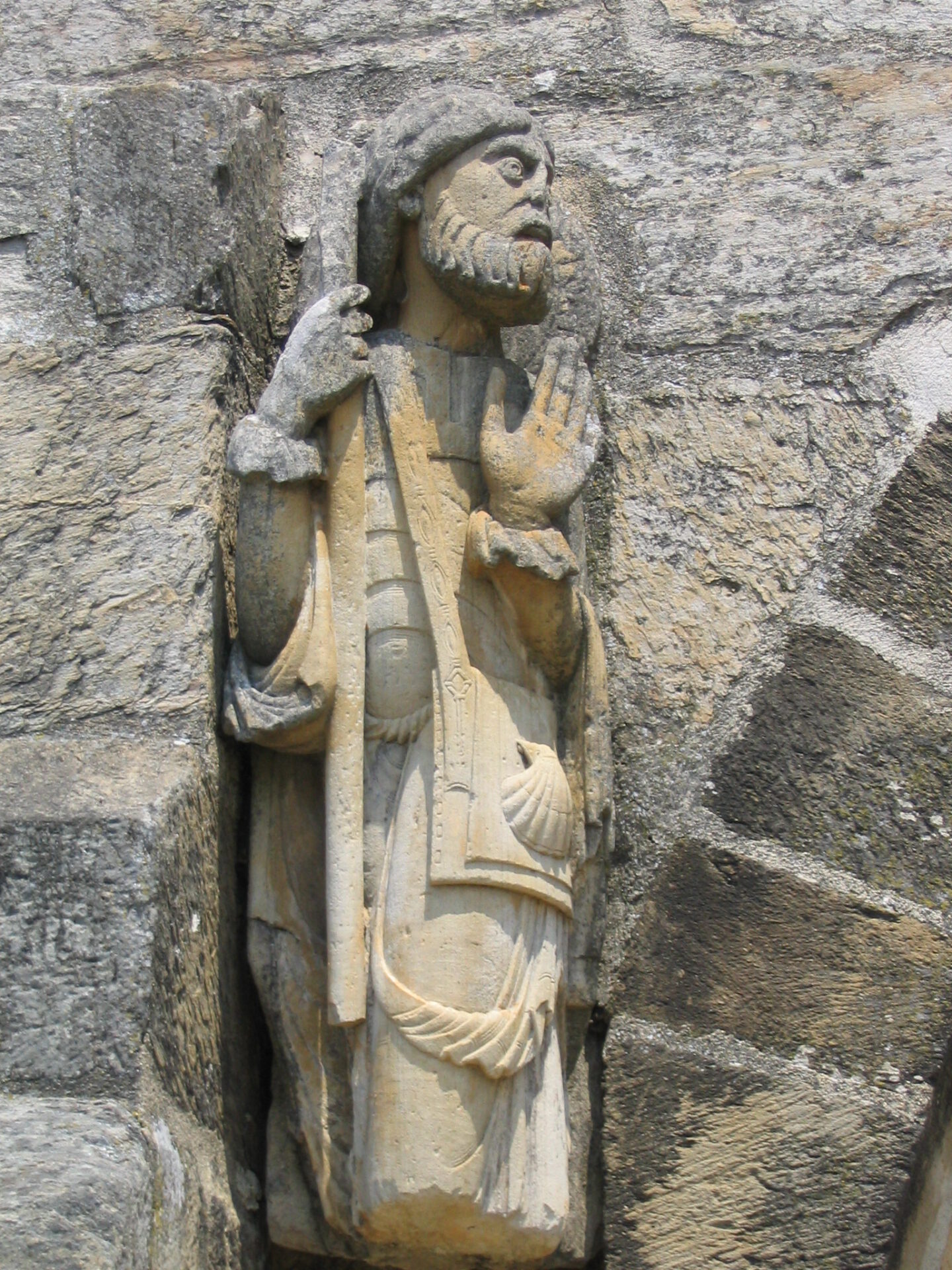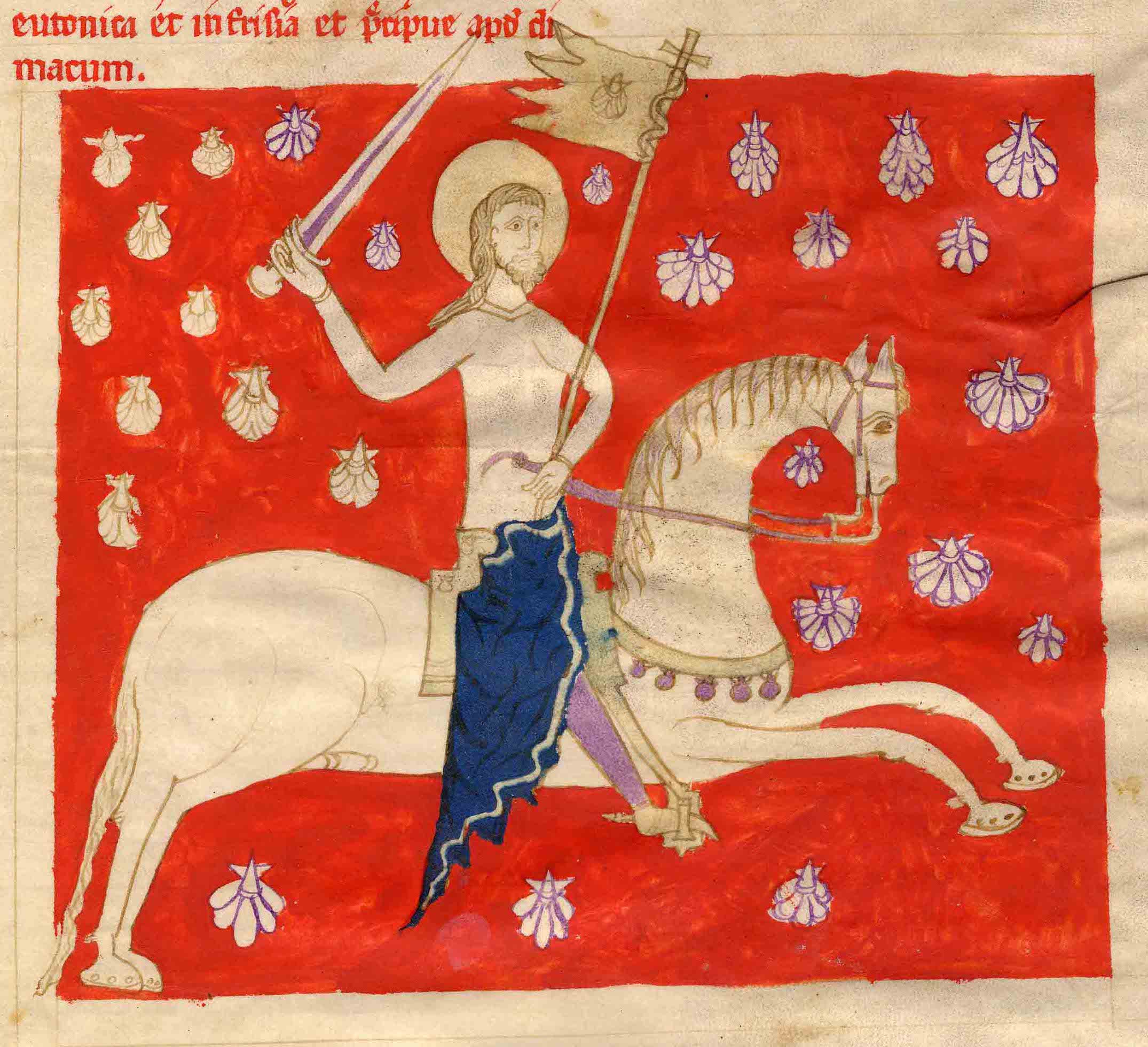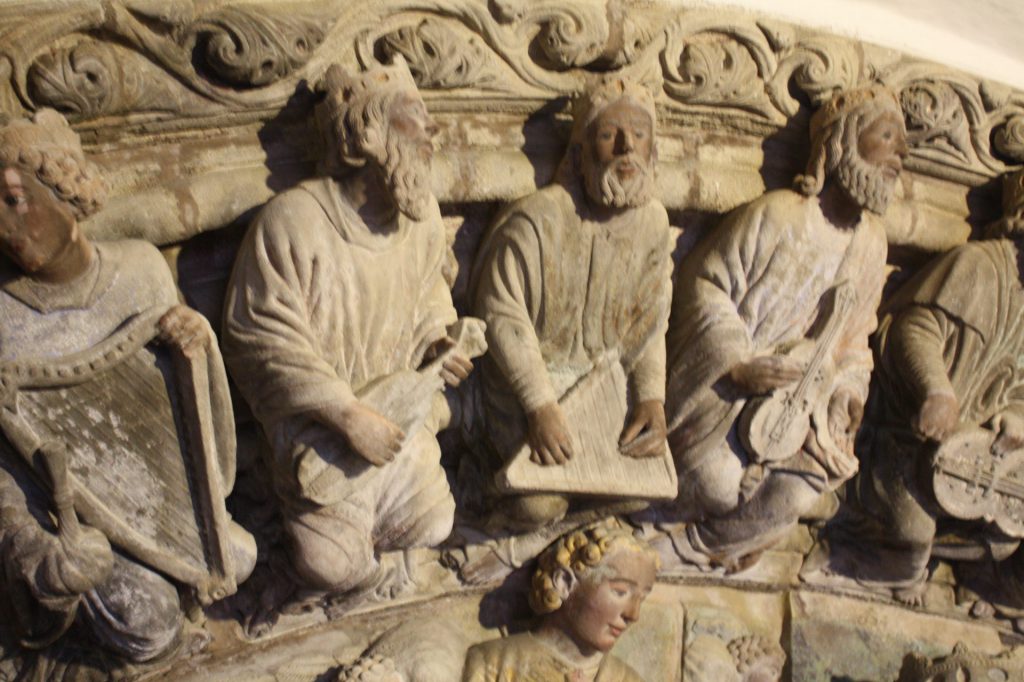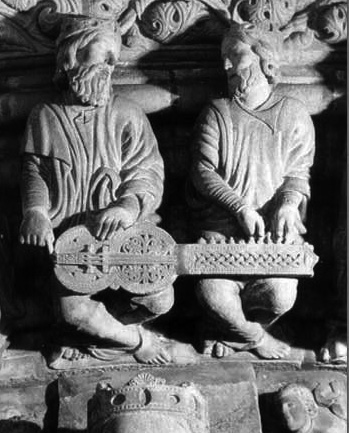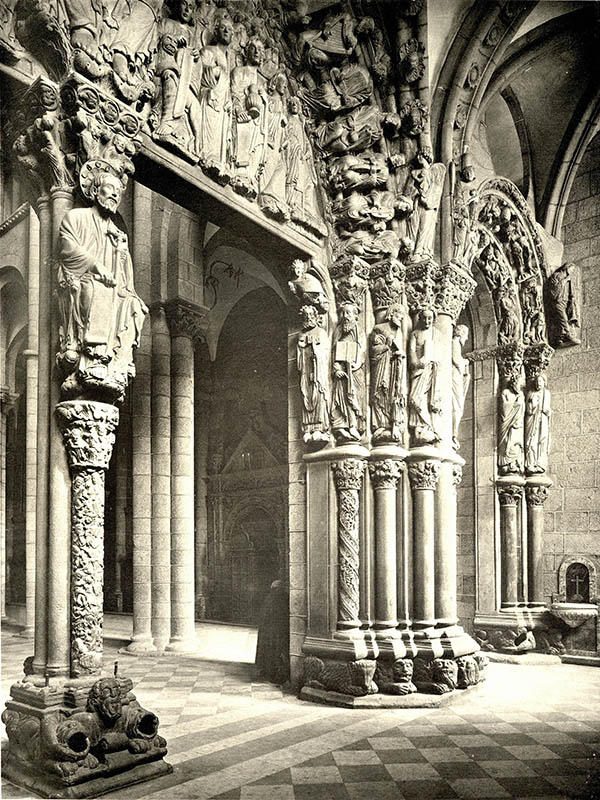
Lineage and Hierarchy at the Pórtico de la Gloria
Introduction
The Pórtico de la Gloria (Portal of Glory), the Cathedral of Santiago de Compostela’s main entrance, was created from 1168 to 1188 by Master Mateo and his workshop.
Although categorized as Romanesque in style, the Pórtico was inspired by both Romanesque and pre-Romanesque religious sites across Europe. Visual elements that emphasize lineage and hierarchy, however, make the Pórtico notable. Permeating the work are elements that encourage viewers to perceive their position within an order larger than themselves, emphasizing one’s state of being a part of the whole. These emphases are related to both the context upon which the twelfth-century cult of St. James was established and the Cathedral of Santiago de Compostela’s position as the Camino de Santiago’s (Way of St. James) final destination.
Tympanum and Archivolt: Many Lineages Collapsed into One
Although medieval pilgrims would commonly have entered the basilica through the north transept portal, the Porta Francigena (now the Puerta de la Azabachería), particular feast days and services that were usually celebrated at the west portal would certainly have brought pilgrims and townspeople alike to the Pórtico de la Gloria.1 Being the entrance to a major religious site, the Pórtico understandably was required to convey its notions on lineage and hierarchy through a backdrop of religious orthodoxy. Expectedly, there is no better place to do this than the tympanum and archivolt (Fig. 1), visual focal points whose iconographical exuberance can overwhelm freshly-arrived pilgrims with strong emotions evoked by diverse biblical themes.
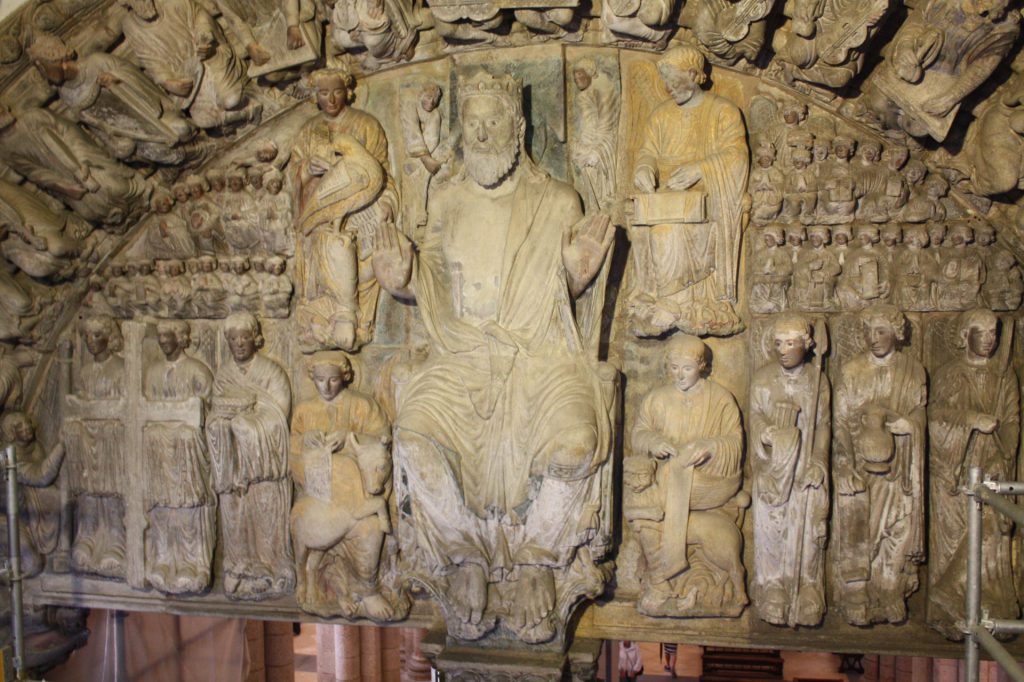
Inspired by the Old Testament and the New Testament Book of Revelation, the biblical backdrop to the Pórtico’s central tympanum and archivolt wields an authoritative energy through the sheer quantity of figures present. Christ in Majesty, flanked by the four evangelists (each identifiable by their attribute), sits in the center. He surmounts eight angels carrying the instruments of the Passion whose formation emphasizes the centrality of the Christ figure through his stage-like appearance—enthroned and displaying his wounds from his crucifixion. On the archivolt, the twenty-four elders of the apocalypse hold musical instruments, as though preparing to celebrate the scene they surround. Both the tympanum’s hieratic scale and the composition of the smaller figures identify Christ as the head of this biblical assemblage, providing viewers with a sense of totality while at the same time emphasizing the figure who governs this total experience.
This emphasis of “oneness” that can be accessed through Christ is especially relevant to Santiago de Compostela for several reasons. The Pórtico and its cathedral occupied a place that was very culturally diverse. Galicia, up to the mid-eleventh century, was characterized by a multicultural social fabric where interactions between Christians, Muslims and Jews were commonplace.2 Pilgrimage, even among Christians, was a heterogeneous affair sustained by believers whose backgrounds and motives varied greatly.3 The “oneness” conveyed by the tympanum is as unifying as the imagery of Santiago Pelegrino (St. James the Pilgrim; Fig. 2a), whose appearance as a pilgrim recalls the saint’s all-inclusiveness and willingness to identify with the faithful.4 What reinforces this unifying effect is the nature of church portals, whose visual richness enabled them to converse with believers from all social levels as “bibles of the illiterate.”5
Following the successes of the Reconquista, enabled by both the emergence of new Christian kingdoms in the Iberian north and the collapse of the Islamic Umayyad dynasty, the less-benevolent image of Santiago Matamoros (St. James the Moor-Slayer; Fig. 2b) gained popularity as the patron saint of Christian kings who fought the Muslims of Al-Andalus, or the Islamic south.6 St. James thus became symbolic of the collaborative Christian effort that was required to eradicate Islam from the Iberian Peninsula. The Reconquista and the Cult of St. James also enjoyed sizable Cluniac sponsorship, and were important parts of the Spanish monarchs’ efforts to integrate Christian Spain with the sociopolitical context of France and other parts of Christian Europe.7 Under these circumstances, St. James and his cathedral represented a greater hierarchical institution that propelled Spanish Christians in a collective battle against the Muslim foes, and concurrently became the visage of an internationalizing Christian civilization. Awareness of all this, of course, would have given even more power to the “oneness” of Christ on the Pórtico’s Tympanum, who in turn governs the iconic character of St. James in the highest of all lineages and hierarchies.
Other than uniting Christian visitors from all over Europe in front of the west entrance through visual and symbolic means, the Pórtico’s tympanum also includes pilgrims and visitors within this biblical narrative through performance. As Castiñeiras proposes, the Easter ritual Triduum sacrum would have been celebrated at the tribune of the cathedral’s Westwerk once Master Mateo finished work on the Pórtico.8 The angels flanking Christ on the tympanum bear the arma Christi—instruments of the Passion—that would actually have been borne by deacons and canons during the Good Friday liturgy.9 Castiñeiras especially points out that “[o]n occasion, two deacons wearing albs carried an Easter cross draped with a cloth, like the pair of angels in the Pórtico.”10 As pilgrims and worshippers took part in the Easter services, they would have noticed the parallel between the sculptural program and the rituals the clergy were carrying out. They would have been equally drawn into the liturgical performance of the Triduum sacrum and the performativity of the figures of Christ, the angels—and let us not forget the music-playing elders of the apocalypse (Fig. 3a-b)—and so felt keenly that they were indeed in communion with Christ and all his saints.
Fig. 3b. (Right) Detail of musical instruments.
The Jambs: Making All Lineages One
Figures of the four prophets (Fig. 4) and the four apostles (Fig. 5), placed on the left and right jambs of the central arch, respectively, incline towards Christ, the most important figure of the Pórtico’s hierarchy. The closeness and parallel placement of the two groups hosts a collapse of biblical time and space, which also involves the biblical figures on the tympanum. This placement of temporally distant biblical characters into a space where they are seen interacting with one another encourages a suspension of disbelief. It also implies that the Pórtico’s paradigm, along with its depicted lineages and hierarchies, can transcend the constraints of time and space. Effectively, this announces that earthly hierarchies are answerable to the greatness and “oneness” of Christ’s hierarchy, and at the same time extends the holy lineage into the earthly context of viewers such that they become accessible. The prophet and apostle groups also indicate the way through which this lineage may be accessed by slanting towards the door of the cathedral and thus inviting their viewer into the church’s interior. Access to the divine order that is greater than oneself does indeed lie at the end of the cathedral’s longitudinal axis, where at the altar the clergy mediates between God and man.

The arrangement of the left jamb’s four prophets contains another assertion of Christ’s role as leader of the greatest of hierarchies. Serafin Moralejo identifies the four figures’ linear arrangement as inspired by the twelfth-century liturgical drama Ordo Prophetarum (Order of the Prophets).11 The motif of the Ordo became popular across Europe due to its drama, and is conveyed at Santiago de Compostela through the specific order by which the four prophets are lined up. Like other twelfth-century Ordo portrayals, the prophet group shows the quartet’s leader to be Moses the lawgiver, who is followed by Isaiah, Jeremiah, and then Daniel. Based on an early-medieval sermon, the Ordo Prophetarum theatrically expresses the idea that the Old Testament anticipated the incarnation of Christ.12 As Castiñeiras observes, on the scroll of an angel-corbel supporting the tympanum is the inscription: “The prophets predicted that the Savior would be born of the Virgin Mary.”13 Given that this drama would have been reenacted on Christmas Eve, it served to unite viewers by showing how even pagan and Jewish prophets declared the true divinity of Christ.14
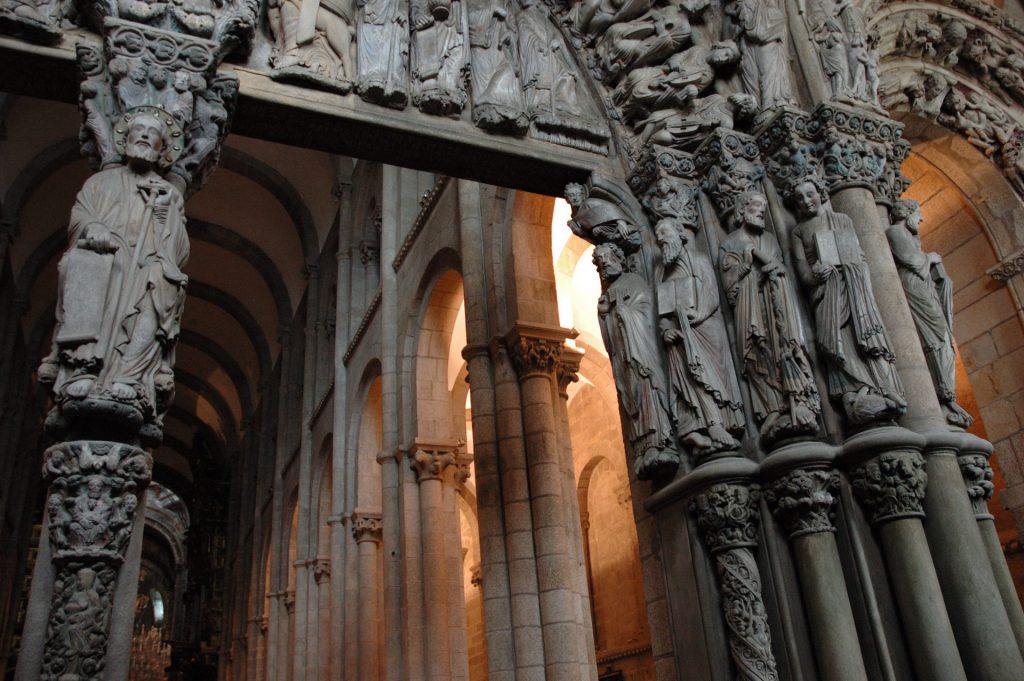
Living Context: Elite Audience and Social Stratification
A great part of what gives strength to the Pórtico’s ideas on lineage and hierarchy is the elite faithful that constitute the cathedrals’ living hierarchical environment. The twelfth-century monarchs of León were often deeply involved in the cult of St. James, and frequently attended the major processions at Santiago de Compostela.15 The Codex Calixtinus describes that kings were often accompanied by socially-stratified entourages whose members dressed and behaved in rigid conformity to their statuses.16 These hierarchical processions mirrored the hierarchies shown on the Pórtico, creating visual echoes that allowed the Church and Christian monarchs to strengthen each other. The Pórtico’s thus becomes a device that artistically supports the might of Christianized royal power, while the kings give currency to Christ’s hierarchy through their faithful participation as prominent and earthly members of the holy lineage.
It would nevertheless be a mistake—a mistake, arguably, that the royalty and the bishop of Santiago de Compostela also made—to suppose that common people at the bottom of this social hierarchy were always docile and faithful worshippers at the cathedral. Even at the time of the completion of the Pórtico de la Gloria in 1188, memory must still have been fresh regarding the town’s revolts.17 Dissatisfied with Gelmírez’s lavish projects—including that of rebuilding the cathedral—the townspeople and “a hostile faction of Gelmírez’s canons” attacked the bishop and the Queen Urraca in 1116-17.18 The revolt became so violent that the queen and the bishop had to, quite undignifiedly, hide in the cathedral bell tower, while the mob set fire to the church.19 Karen Matthews remarks that Gelmírez’s canons, who were supposed to be intimate with and supportive of the bishop, were also displeased with his attempts at reforming the conduct of clergy.20 The same causes provoked another rebellion in 1136, where Gelmírez “barely escaped assassins.”21 It seems that no matter how rigidly biblical hierarchy—and by extension social stratification—was enforced, there always were times when the people realized that they could take action from the ground up and upend the normally unidirectional hierarchy, at least for a while. This curious phenomenon is also manifest in the Tree of Jesse on the trumeau.

Trumeau and the Tree of Jesse: Interaction, Introspection, and Involvement
The Pórtico’s trumeau (Fig. 5) supports a statue of St. James (Fig. 7) that is in turn surmounted by the central tympanum. Its dialogue of lineage and hierarchy is in its resemblance to a Tree of Jesse, a motif that invokes Christ’s human ancestral lineage. The portico’s tree pales in comparison to the highly-standardized fourteenth and fifteenth-century historiated Tree of Jesse’s, whose designs can all be traced back to a (now non-existent) thirteenth-century original; whose closest reproduction is a fourteenth-century Tree of Jesse now located at the Duomo di Orvieto cathedral in Umbria, Italy.22 Although preceding the Orvieto version by two centuries, Santiago de Compostela’s Tree of Jesse bears many iconographical elements that the Orvieto Tree copied from earlier twelfth- and thirteenth-century Jesse Trees. Similarities between the two trees show a clear sharing of artistic vocabulary. Both trees feature Christ atop a central trunk that is surrounded by a cacophony of biblical figures. The human figures embedded within the vine motifs on the Santiago trumeau interestingly recall the Orivieto tree’s acanthus roundels framing the seven figures placed vertically between a reclining Jesse and Christ.23
Clearly, the Santiago Tree is ideologically conversant with its Orvieto counterpart, which in its fourteenth-century context acted as a reminder that only the Church could legitimately bestow apostolic rights (a response to a periodic surge of Catharism and heretical free-preaching).24 The Santiago Tree’s reference to legitimate apostolic right takes place in the Tree’s proximity to the prophet and apostle groups on the jambs. Its placement of St. James below Christ on the central tympanum even arguably renders it more relevant to apostolic lineage than genealogical lineage. Where the two Trees truly resonate in their symbolic dialogues is in their manifestations of what the faithful’s hands mean to the lineages they carry.
In many of its roundels, Orvieto’s Jesse Tree shows scenes of hands being placed on the heads of biblical figures. Michael Taylor notes that the Imposition of Hands (a liturgical gesture where a priest lays his hands on a person’s head in a gesture of blessing) has since the early Christian period symbolized the Church’s willingness to reconcile with penitent heretics.25 Through this motif, the Orvieto tree expresses the Church’s readiness to accept the contrite into the holy lineage. Curiously, this ritual “Imposition of Hands” appears reversed at the Santiago Tree, where pilgrims instead laid their hands on the Jesse Tree in a display of willingness to join the holy lineage; and, noticeably, the sheer number of pilgrims who participated in this ritual resulted in the wearing of a handprint into the trumeau’s stone. It cannot be claimed that all pilgrims were aware of the Imposition of Hands when they touched the Santiago Tree. However, the Santiago and Orvieto Jesse Trees show that the connection between the act of touching and admission into the holy lineage was an inherited idea that travelled with the Tree of Jesse’s motif.
Another lineage is contained at the back of the Pórtico’s trumeau, where a small statue of Master Mateo lies at its base. Similar to an artist signature, the statue is Mateo’s mark on his creation. Interestingly, Mateo borrowed the Tree of Jesse’s symbolism to assert his place in both religious and artistic lineages. Like the handprint at the trumeau’s front, the statue is a permanent imprint announcing that his spiritually-significant labor has resulted in his deserved reward of being admitted into the holy lineage. This mark, however, also declares his place in an artistic succession. Peter and Linda Murray state that the tympanum of the Pórtico recalls the Christ in Majesty at the Moissac portal, while the sculpture of its trumeau and jambs resemble those of Vézelay’s triple portals.26 Admittedly, these artistic transferences might partly be explained by Cluniac sponsorship of the cult of St. James, even though Cluniac influence would have been felt more strongly in the eleventh than in the twelfth century, when work on the Pórtico was underway.27 It is curious to note that Moissac and Vézelay were both Cluniac abbeys, and as Graham and Murray observe as the result of the spread of Cluniac power into Spain, “Romanesque styles predominated—as in the now largely destroyed Cluniac monastery at Sahagún and the spectacular Portico de la Gloria [sic] in Santiago’s cathedral itself.”28

Nevertheless, that is certainly not to say that Master Mateo just took features of predominant, especially French, Romanesque portals and had them put up on his Pórtico as well—quite the contrary. Graham and Murray do call it “spectacular” while naming it as one of the manifestations of the Romanesque. Articulating Mateo’s own ingenuity in reinventing these inherited features might just bring us back to the Ordo Prophetarum liturgical drama. As Castiñeiras puts it:
Mateo’s originality lay in enlivening the entire space of the western narthex of the basilica for the unfolding of this drama. Here, the prophets are not confined to the interior frontis, but they line the facing wall of the outer façade as well, enveloping the spectator in a forest of figures dramatizing salvation history.29
Indeed, Mateo’s prophets are close to life-size, and are nearly free-standing sculptures, each with their own facial expressions, and once “painted with sumptuous and brilliant colors, using red of minium and cinnabar, lapis lazuli for blue and gold leaf.”30 They must have seemed to medieval pilgrims to be almost one with them—with flesh and bone—only more dignified and inspiring of awe and emulation. The capacity for the Pórtico to invite visitors’ and pilgrims’ participation is why Castiñeiras judges that it “presents the most complete example of the impact of this paraliturgical ceremony in the iconography of Romanesque monumental art.”31 In this light, Mateo may have been most concerned with securing his place within a lineage defined by both artistic genius and stylistic transmission that is unavoidably tangled with the political and social landscapes of the day.
There is also the matter of the symbolic lineage of Master Mateo’s occupation as an artist. On Jeremiah’s scroll Mateo added the inscription: “All is the work of the artists.”32 Castiñeiras elucidates that the phrase is taken from “Jeremiah’s denunciation of false idols (Jeremiah 10:9).33 In this light, the text on the jamb reads, paradoxically, as both assertion of Mateo’s own artistic genius in creating the Pórtico and a warning to viewers against worshipping the figures on the sculptural program. Yet, as Castiñeiras also notes, the small sculpture of the kneeling Mateo at the back of the trumeau shows sufficient humility towards God as “the Almight Creator (Primum Artifex).”34 Mateo basically declares that his genius as an artist ultimately came from God, as he himself had been made in God’s image.
Conclusion: A Work of Masterful Persuasion?
The Pórtico de la Gloria conveys the benefits of pilgrimage and the faithful worship of its saint through a dialogue that explores the individual’s place within greater orders. Yet, it was itself much influenced by the lineages and hierarchies that shaped the cult of St. James. Its success lies much in its ability to convince viewers that its host cathedral is the answer to their desire to become part of the earthly but divine.
Bibliography
Abou-El-Haj, Barbara. “The Audiences for the Medieval Cult of Saints.” Gesta 30, no. 1 (1991): 3–15.
———. “Santiago de Compostela in the Time of Diego Gelmírez.” Gesta 36, no. 2 (1997): 167-69.
Bevington, David. Medieval Drama. Indianapolis: Hackett Publishing, 1975.
Castineras, Manuel. “The Topography of Images in Santiago Cathedral: Monks, Pilgrims, Bishops and the Road to Paradise.” In Culture and Society in Medieval Galicia: The Cultural Crossroads at the Edge of Europe, edited by James D’Emilio, 631–94. Boston: Brill, 2015.
———. “The Romanesque Portal as Performance.” Journal of the British Archaeological Association 168, no.1: 1-33.
Graham, Brian, and Michael Murray. “The Spiritual and the Profane: The Pilgrimage to Santiago De Compostela.” Ecumene 4, no. 4 (October 1997): 389–409.
Matthews, Karen Rose. “Reading Romanesque Sculpture: The Iconography and Reception of the South Portal Sculpture at Santiago de Compostela.” Gesta 39, no. 1 (2000): 3-12.
Murray, Peter, Linda Murray, and Tom Devonshire Jones, eds. The Oxford Dictionary of Christian Art and Architecture. Seconded. Oxford University Press, 2013.
Taylor, Michael D. “A Historiated Tree of Jesse.” Dumbarton Oaks Papers 34 (1980): 125–76.
Image Credits
Header. Collotype of the Pórtico de la Gloria. Source: Wikipedia https://en.wikipedia.org/wiki/Santiago_de_Compostela_Cathedral#/media/File:036_Santiago_(da_Compostela)_Portico_de_la_G_loria_in_der_Kathedrale.jpg. Public Domain License.
Fig. 1. Tympanum and archivolt of the central arch. Source: Wikipedia. https://en.wikipedia.org/wiki/Portico_of_Glory#/media/File:Portico_da_Gloria_11-14d.JPG. Licensed under CC BY-SA 4.0.
Fig. 2a. Statue of St. James as Santiago Peregrino (St. James the Pilgrim) at the south portal of the Church of Santa Marta de Tera, Zamora, Spain,12th century. Photograph by Pierre Henri GIRAUD, July 13, 2003. Source: Wikipedia, https://es.wikipedia.org/wiki/Santa_Marta_de_Tera#/media/Archivo:Saint-Jacques_Route_de_la_Plata.jpg. Licensed under CC BY-SA 2.5.
Fig. 2b. St. James as Santiago Matamoros (St. James the Moorslayer), f. 120, final illumination in Codex Calixtinus de Salamanca, probably made in Santiago de Compostela, c.1325. Now preserved at the Biblioteca de la Universidad de Salamanca, Ms. 2631. Photograph by Certo Xornal, November 25, 2010. Source: Wikimedia Commons, https://commons.wikimedia.org/wiki/Category:Codex_Calixtinus#/media/File:Codex_Calixtinus.jpg. Cropped image licensed under CC BY-SA 2.0.
Fig. 3a. Musicians on the archivolt. Source: Wikipedia. https://en.wikipedia.org/wiki/Portico_of_Glory#/media/File:Portico_da_Gloria_11-17.JPG Licensed under CC BY-SA 4.0.
Fig. 3b. Musicians on the archivolt. Source: Wikipedia. https://en.wikipedia.org/wiki/Santiago_de_Compostela_Cathedral#/media/File:Organistrumsantiago20060414.jpg. Licensed under CC BY-SA 3.0.
Fig. 4. Trumeau and prophets of the Old Testament. Source: Wikipedia. https://en.wikipedia.org/wiki/Portico_of_Glory#/media/File:Santiago_Catedral_Pórtico_da_gloria_GDFL6.JPG. Licensed under CC BY-SA 3.0.
Fig. 5. Painting: El Pórtico de la Gloria de la Catedral de Santiago de Compostela by Jenaro Pérez Villaamil. Source: Wikipedia. https://en.wikipedia.org/wiki/Portico_of_Glory#/media/File:El_Pórtico_de_la_Gloria_de_la_Catedral_de_Santiago_de_Compostela,_1849,_Jenaro_Pérez_Villaamil,_Palacio_de_la_Moncloa,_Madrid.JPG. Public Domain license.
Fig. 6. Trumeau and four apostles on the right inner frontis. Source: Wikipedia https://en.wikipedia.org/wiki/Santiago_de_Compostela_Cathedral#/media/File:Interior_Catedral_Santiago_de_Compostela.jpg. Licensed under CC BY-SA 3.0.
Fig. 7. Statue of Saint James on trumeau of central arch. Source: Wikipedia. https://en.wikipedia.org/wiki/Portico_of_Glory#/media/File:Parteluz_de_l_pórtico_de_la_Gloria.jpg. Licensed under CC BY-SA 3.0.

